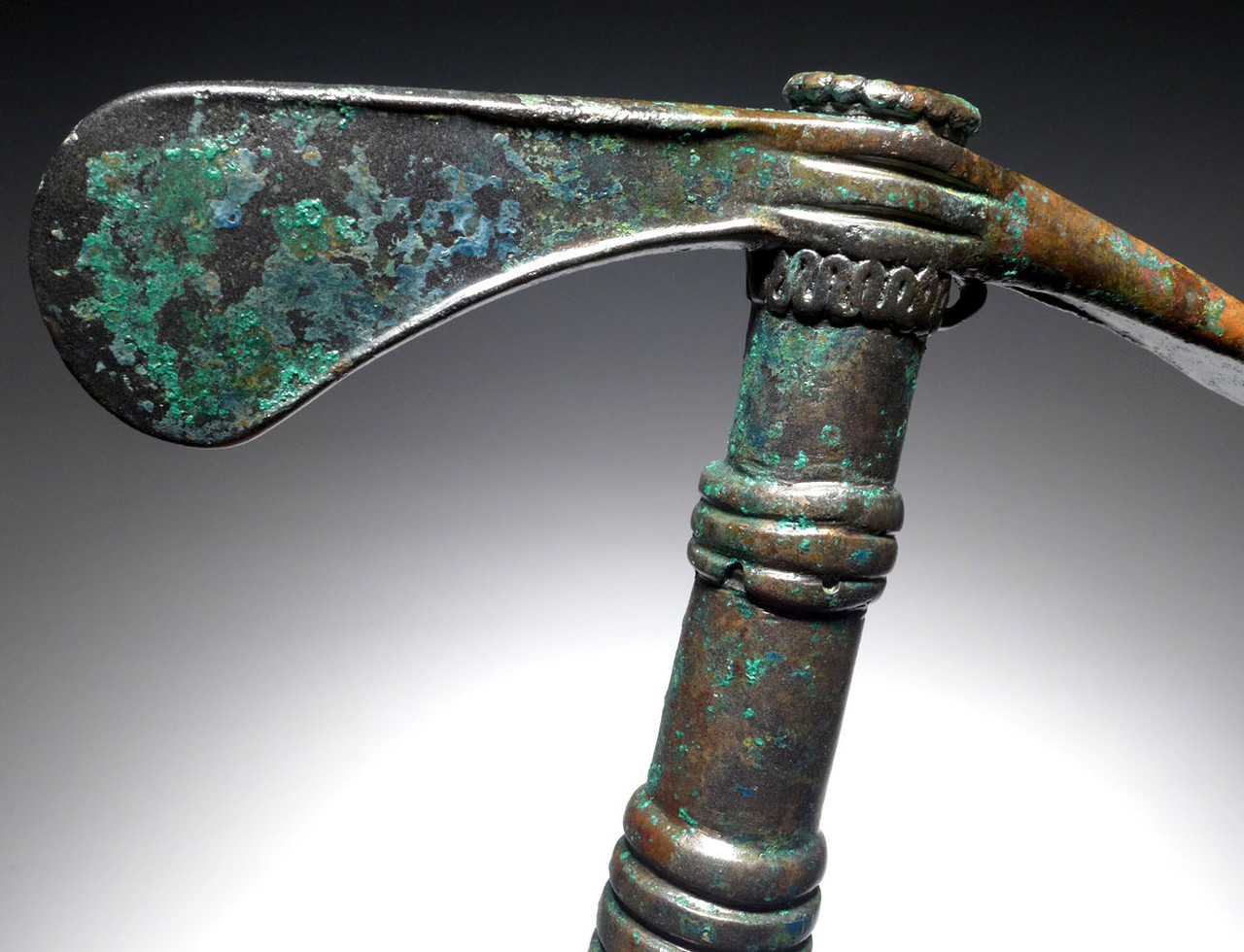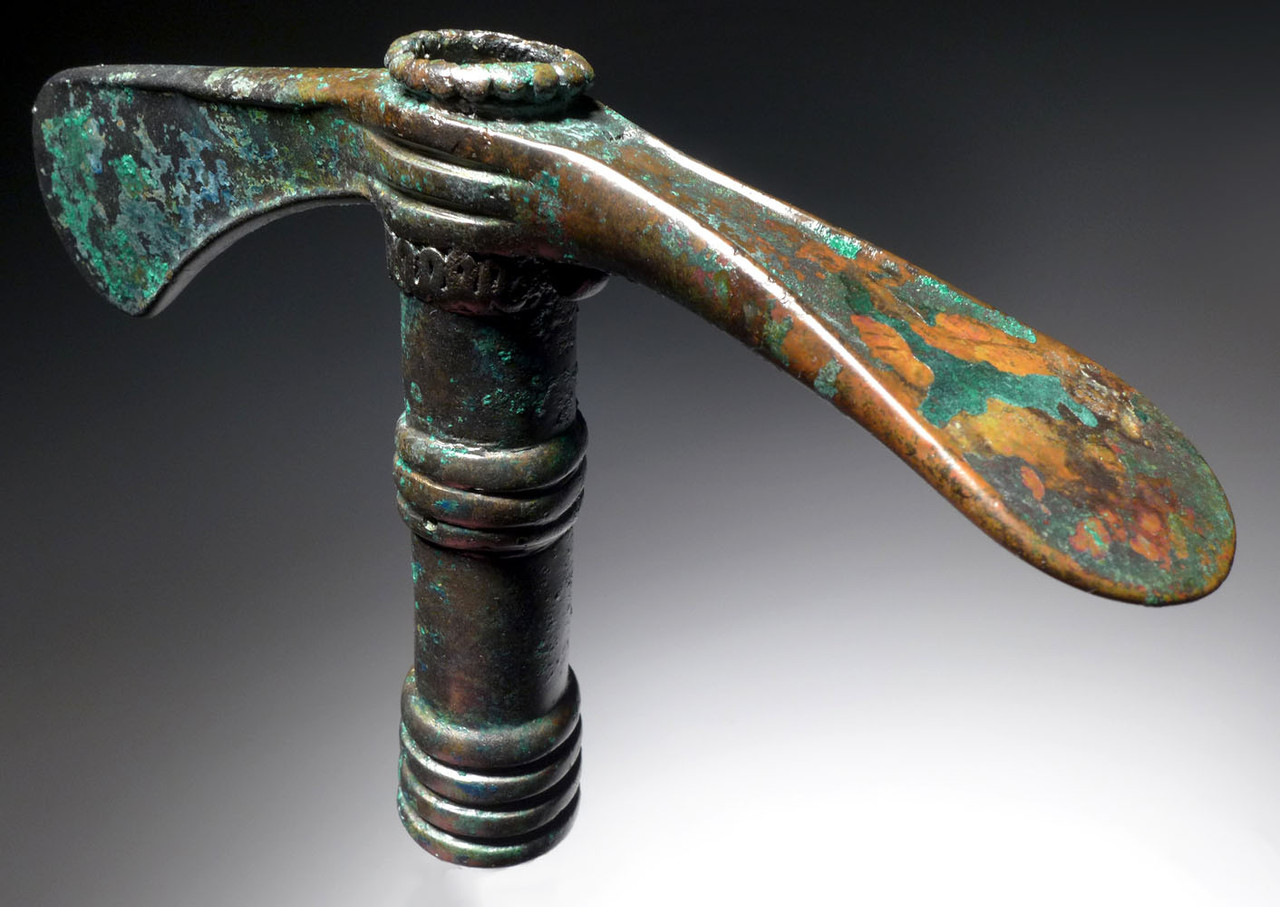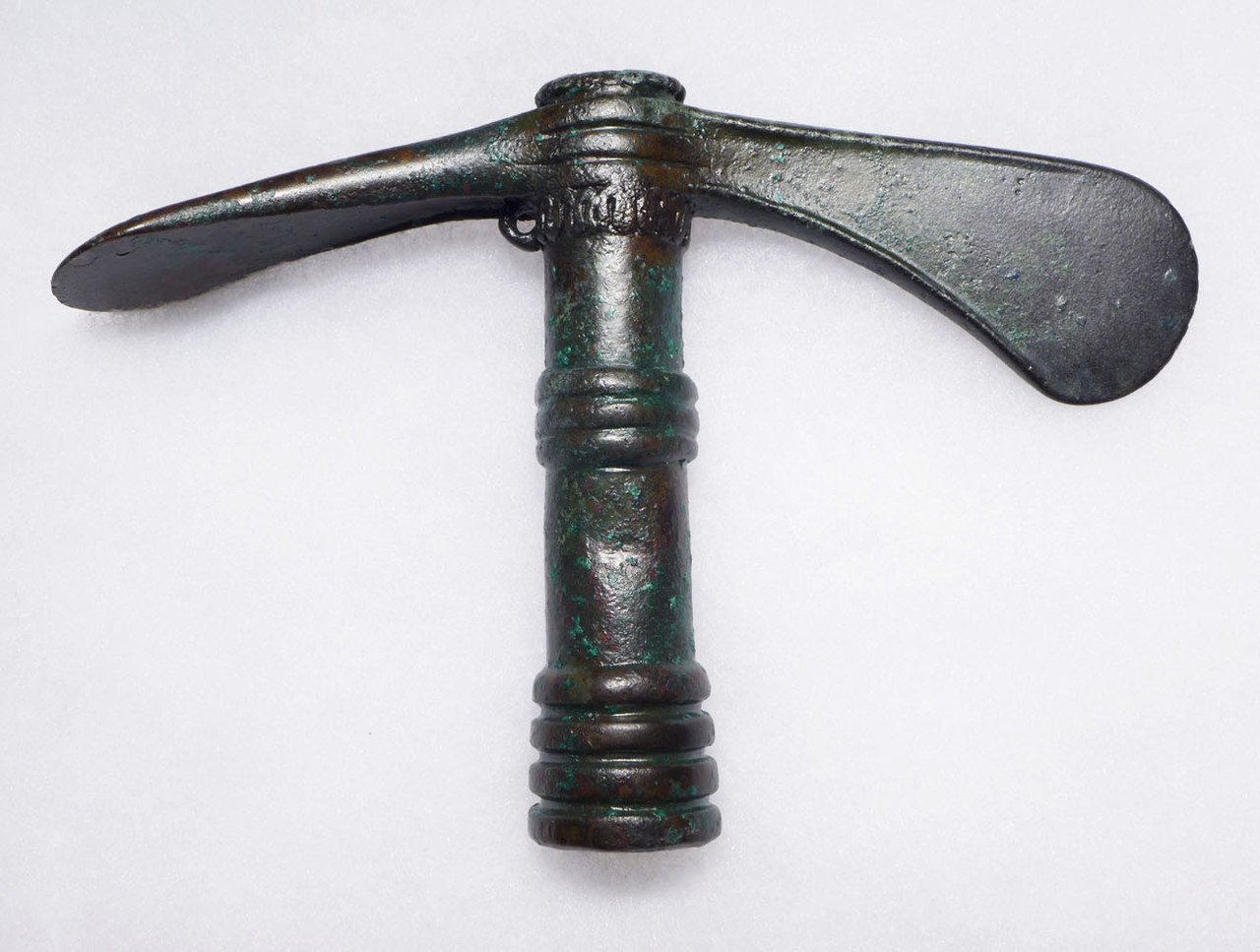Product Description
SEE MORE ANCIENT NEAR EASTERN LURISTAN ARTIFACTS
In ancient times, there were ordinary weapons for the common soldier, and elaborate prestige weapons reserved for the highest ranking officers and wealthiest noble warriors. Ancient prestige weapons like this, were rare in ancient times as they are today. This is a RARE offering of a true MUSEUM-CLASS large decorated adze axe with long shaft body. It comes from the ancient Near Eastern Luristan Culture and excavated examples like it have dated to the Iron Age III. Such an impressive and large axe was functional but also a battlefield display of rank and status.
Most museums lack ancient weapons in their collections of this caliber. Even in ancient times, this adze axe would have been extremely scarce. No ordinary ancient warrior could have ever hoped to purchase an axe like this, and it was most certainly a weapon of pride and display as very, very few ancient weapons of this type exist. The loop on the rear underside of the axe head was for attaching a cord or chain that was affixed to the shaft. The reason for this is if the axe broke from the shaft, it would not be lost. It was that precious even in ancient times!
Very seldom do ancient bronze weapons appear on the market of this magnitude and quality. The bronze preservation is exceptional and the entire axe is complete, 100% original and without any damage or alterations. Ancient blue azurite and green malachite mineral encrustations are scattered over the patinated surface. This amazing ancient bronze adze axe shows superb bronze preservation with no disease or corrosion.
This artifact has been professionally cleaned and conserved in our lab, being treated with a special sealer developed and formulated by us specifically for ancient metal preservation. The patina shows beautiful traits only found in authentic ancient weapons. It is a patina like this that the finest ancient bronzes are prized for and it is a patina like this that brings a premium in price and value of the specimen. There is no active bronze disease. Bronze disease can develop on ancient bronze that is not properly cleaned and conserved. It produces a corrosive powder that will literally eat away an artifact over time and destroy it.
WARNING: There is a STAGGERING number of fake bronze weapons on the market. Many being sold as "authentic" were never meant to deceive and were made as far back as 100 years ago as exact reproductions for museums to sell in their gift shops. Other examples are modern fabrications specifically intended to fool unwitting buyers. As fine quality intact, original specimens become more scarce, the techniques to fake these objects have become highly advanced. We have personally handled numerous well-done fakes with extremely convincing patinas. The degree to which the fakers have been able to replicate patina to disguise their work requires an expert examination by highly experienced individuals. It is common to find very reasonably priced weapons that are made up of part original and part modern components or wholly modern pieces displaying elaborate artificial patinas. All purchases should include a written guarantee of authenticity from the seller, with unconditional and lifetime return policies regarding such guarantee, such as we provide.
HISTORY
With origins dating back to prehistory, the empire of ancient Iran was one of the world's first superpower civilizations by the time it had taken form in the second millennium B.C.. The various cultures that can be included in the former ancient Iranian Empire stretched across an enormous geographical region extending beyond what is called the Iranian Plateau. To gain insight as to just how large this area was, the Iranian Plateau alone, includes Iran, Afghanistan and Pakistan and comprises approximately nearly 4 million square kilometers (almost 1.5 million square miles). The area of ancient Iran included not only the massive Iranian plateau made up of the tribes of the Medes, Persians, Bactrians and Parthians, but also included groups as far west as the Scythians (an eastern Scythian tribe existed in parallel in Central Asia), Sarmartians, Cimmerians and Alans populating the steppes north of the Black Sea. To the eastern boundary of the empire, the Saka tribes dominated, spreading as far as Xinjiang, China. From a very early period, the ancient Iranian peoples have been historically documented to exist in two separate continuums - a western civilization (Persia) and an eastern civilization (Scythia).
The beginnings of ancient Iran trace back to an influx into the Iranian cultural region of bands of horse-mounted steppe nomads from Central Asia, speaking Indo-European languages. Some settled in eastern Iran but other groups migrated deeper to the west settling in the Zagros Mountains. These first people descended from the proto-Iranians, originating from the Central Asian Bronze age culture of what is called the Bactria-Margiana Complex (aka Oxus Civilization), dated 2200-1700 B.C..
This historical achievements and the breadth of diverse cultures included of this once great empire are too vast to adequately credit in this brief synopsis. The Islamic conquest of Persia in the middle of the 7th century A.D. and the collapse of the Sassanid Empire marked the end of once geographically expansive and culturally diverse ancient superpower.
The term LURISTAN references artifacts made by a society of semi-nomadic people that once lived in the mountainous region of Northwest Iran. Little is known of this ancient culture but the most impressive traces are that of the bronze artifacts they left behind that can be found in parts of present-day Turkey, Iran and Afghanistan. These include highly decorative equipment for their horses, ceremonial containers and numerous weapons ranging from simple utilitarian pieces on up to elaborate masterpieces of warfare.
It is theorized that the Luristan bronzes were crafted by the earliest existence of the Median empire but this has never been proven as written records of the Medes have not survived. The Medes were Indo-Iranian people originally from central Asia who settled in Northwest Iran in the 9th century BC and later defeated the Assyrian empire in 614 BC. Their success is short-lived and their empire which once stretched from central Iran to the Persian Gulf and Anatolia was overrun in 550 BC by the Persians.
 US DOLLAR
US DOLLAR
 EURO
EURO
 AUSTRALIAN DOLLAR
AUSTRALIAN DOLLAR
 CANADIAN DOLLAR
CANADIAN DOLLAR
 POUND STERLING
POUND STERLING






















